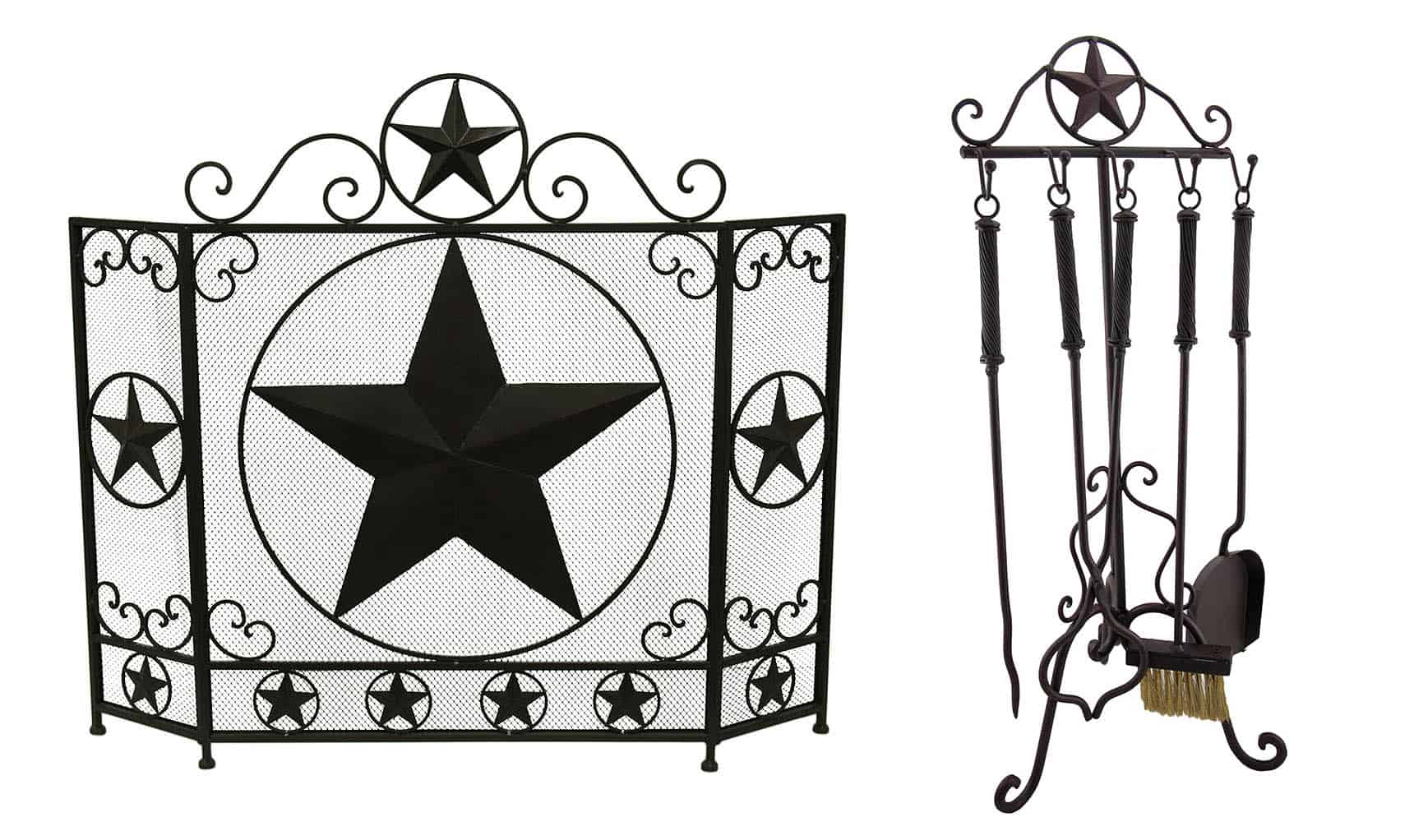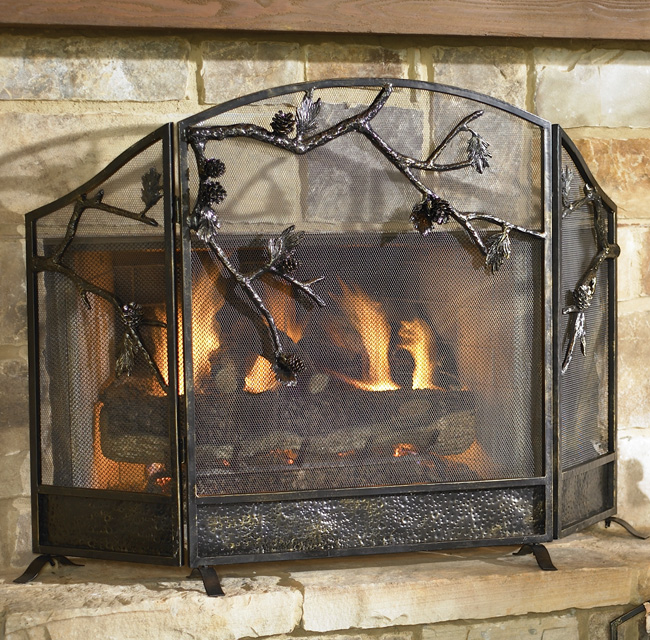Rustic western fireplace screens bring charm, warmth, and authenticity to hearth areas. They aren’t just practical—they’re a centerpiece for those looking to introduce frontier-style design into their homes. Whether you live in a ranch house or want to add rugged beauty to a suburban living room, these screens can transform your fireplace into a cozy, inviting space. From hammered iron to leather accents, they reflect craftsmanship and a strong connection to heritage.
Key Features That Define Rustic Western Fireplace Screens
-
Western fireplace screens are usually built from sturdy metals like wrought iron or steel. These materials don’t just last; they look and feel substantial. The weight and texture of the metal give the screen a presence that suits the rugged charm of western design.
-
Many rustic screens feature decorative elements like horseshoes, rope motifs, pine trees, or wildlife silhouettes. These patterns reinforce the screen’s character and connect it to themes like ranch life, cowboy culture, or open landscapes.
-
A natural, weathered finish is common. Instead of shiny coatings, rustic fireplace screens often use patinas, oil-rubbed bronze, or aged iron textures. This creates a more authentic feel and keeps the piece from looking too modern or industrial.
-
Some western screens incorporate rawhide, suede, or leather panels into the frame. These additions give the piece a handcrafted appearance while referencing saddlework, boots, and other leather goods common in cowboy life.
-
Scrollwork and hand-hammered details are another hallmark. These elements show artisan skill and nod to blacksmith traditions. No two screens are exactly the same when handmade, and slight imperfections are part of their charm.
-
Mesh or wire panels serve a safety function but are also designed to match the screen’s rustic theme. Whether painted black or bronzed, the mesh blends in without drawing too much attention. It provides essential protection while keeping the style intact.

Design Styles That Match Rustic Western Screens
A classic log cabin look pairs perfectly with these screens. Think knotty pine walls, stone fireplaces, and cozy textiles. A fireplace screen featuring elk or bear silhouettes works especially well in this type of setting.
Southwestern style also blends well. This includes adobe walls, warm-toned tile, and terra cotta accents. Here, a screen with geometric cutouts or leather lacing can help bridge the gap between traditional western and native-inspired decor.
For a ranch or farmhouse setting, screens with horseshoe or star details match nicely. These pieces can stand out against brick or reclaimed wood surrounds, adding texture and a bit of storytelling to the hearth.
Western contemporary interiors can use sleeker versions of rustic screens. A minimal wrought iron screen with light distressing fits right in with modern furniture while still holding onto its rural inspiration.
For themed rooms like a western-style den or lodge-inspired great room, large three-panel screens with wildlife scenes or lasso-style scrolls can become focal points. These bolder designs emphasize character and craftsmanship.
Rustic eclectic homes, which mix vintage western pieces with industrial or bohemian accents, also benefit from these screens. Their handmade quality fits well alongside reclaimed furniture and antique accessories.
Benefits of Using Rustic Western Fireplace Screens
These screens offer more than aesthetics. They serve an important safety purpose by keeping sparks, embers, and ash from reaching nearby rugs or floors. This is especially critical with wood-burning fireplaces.
Western screens add warmth and personality to the space. Instead of looking cold or generic, they provide a sense of place and history, making the room feel more grounded and welcoming.
They are built to last. Materials like wrought iron and solid steel don’t easily bend, rust, or warp. When cared for, a rustic western fireplace screen can last decades with minimal maintenance.
Custom designs are widely available, allowing you to match the screen to your specific taste. Whether you want a lone star motif or a bucking bronco design, there’s an option out there to suit your vision.
Some rustic fireplace screens are designed with folding panels, which make them easier to move and store. These hinged designs are both functional and decorative, offering flexibility while maintaining style.
Many screens come with matching fireplace tool sets or log holders. Choosing a full set can enhance the cohesiveness of your fireplace area, giving it a polished and intentional feel without sacrificing rustic character.
How to Choose the Right Screen for Your Fireplace
Measure your fireplace opening before shopping. You want the screen to fully cover the firebox while maintaining a balanced look. Oversized screens can overwhelm the space, while undersized ones leave gaps and lose visual impact.
Consider your fireplace type. For wood-burning fireplaces, a mesh-backed screen is necessary for safety. If you use gas logs or a sealed insert, a screen can be purely decorative, giving you more freedom in your design choices.
Match the finish to other metals in the room. If your lighting or furniture uses oil-rubbed bronze or black iron, select a screen that complements those tones. This creates visual harmony and keeps the design consistent.
Decide if you prefer a flat or folding screen. Flat screens are sleek and often more stable, while folding panels provide flexibility and a more dynamic shape that frames the firebox with interest.
Think about storage and seasonal use. If you don’t burn fires year-round, you might want a screen that’s easy to move or store. Lightweight folding screens are ideal for this purpose, especially in warmer climates.
Look for artisan or handcrafted options if authenticity matters to you. Many smaller workshops specialize in rustic western designs, offering pieces made with traditional techniques rather than mass-produced molds.
Caring for and Maintaining Rustic Fireplace Screens
Regular dusting helps preserve the appearance of metal screens. Use a soft cloth or brush to remove ash or dirt. If you burn wood often, clean the screen weekly to prevent soot buildup that can stain over time.
Avoid harsh chemicals that can strip the patina or protective coating. Instead, use warm water and mild soap. For textured or hammered surfaces, a soft-bristled brush helps clean hard-to-reach crevices without scratching.
If your screen has leather or suede accents, treat them with leather conditioner every few months. This prevents cracking or drying, especially if your fireplace generates a lot of dry heat during winter months.
Inspect for rust annually, especially at weld joints or hinges. If you find any, gently sand the area and apply touch-up paint designed for high-heat metal. This prevents rust from spreading and maintains the screen’s integrity.
Store unused screens in a dry place. If you swap out your screen seasonally or only use it for display, wrap it in a blanket or towel to prevent scratches. Keep it off concrete or stone floors to avoid moisture contact.
Check the mesh occasionally for warping or separation from the frame. This is especially important if children or pets are near the fireplace. A secure screen offers both protection and peace of mind.
Common Mistakes to Avoid
Using indoor-only screens outside: Many rustic designs are also sold for patio use, but not all are weather-safe.
Ignoring measurements: An improperly sized screen will look awkward and may not offer proper protection.
Neglecting maintenance: Rust and dirt can build up if not cleaned regularly, shortening the screen’s life.
Choosing the wrong material: Light metals bend easily and don’t offer the same durability as wrought iron.
Over-styling the space: Too many western accents can clutter the area—let the screen stand out.
Blocking airflow: Some thick screens can inhibit heat from reaching the room if placed too close to the firebox.
Are rustic western screens just decorative, or do they offer real protection?
They’re both functional and decorative. Most are built with heavy-duty materials like wrought iron, making them strong enough to block sparks, embers, and heat. Screens with mesh panels offer the best protection for active fireplaces.
Can I use these screens with gas fireplaces?
Yes, rustic western screens can be used with gas fireplaces. In that case, their role is mostly aesthetic. Just make sure the screen doesn’t block any ventilation or safety mechanisms built into the gas unit.
Are there custom options for rustic western designs?
Absolutely. Many artisans and blacksmiths offer made-to-order screens. You can specify dimensions, patterns, finishes, and even add personal details like initials, branding symbols, or ranch logos.
Do these screens require a lot of maintenance?
Not much. Regular dusting and occasional cleaning with a damp cloth are usually enough. If your screen includes leather or suede, it may require seasonal conditioning. Most metal frames only need rust checks once a year.
Can I find matching accessories for a cohesive look?
Yes. Many rustic fireplace collections include matching tool sets, log holders, and even andirons. These create a unified design while adding useful features around your hearth.
Where can I buy a rustic western fireplace screen?
You can find them online through specialty retailers, home design stores, or local blacksmith shops. Handmade options may cost more, but they offer better craftsmanship and uniqueness compared to mass-produced versions.
Running Horses Western Fireplace Screen – Southwestern Decor
Rustic Brown Western Star Metal Fireplace Screen and 5 Piece Tool
Pin by JUST ALICIA on HIS DEN Rustic fireplaces, Fireplace doors
Pinecone Fireplace Screen
COWBOY ROUND-UP FIREPLACE SCREEN Tri-Fold Rustic Western Scene
Decorative Metal Heavy Foldable Fireplace Screen with
Related Posts:











